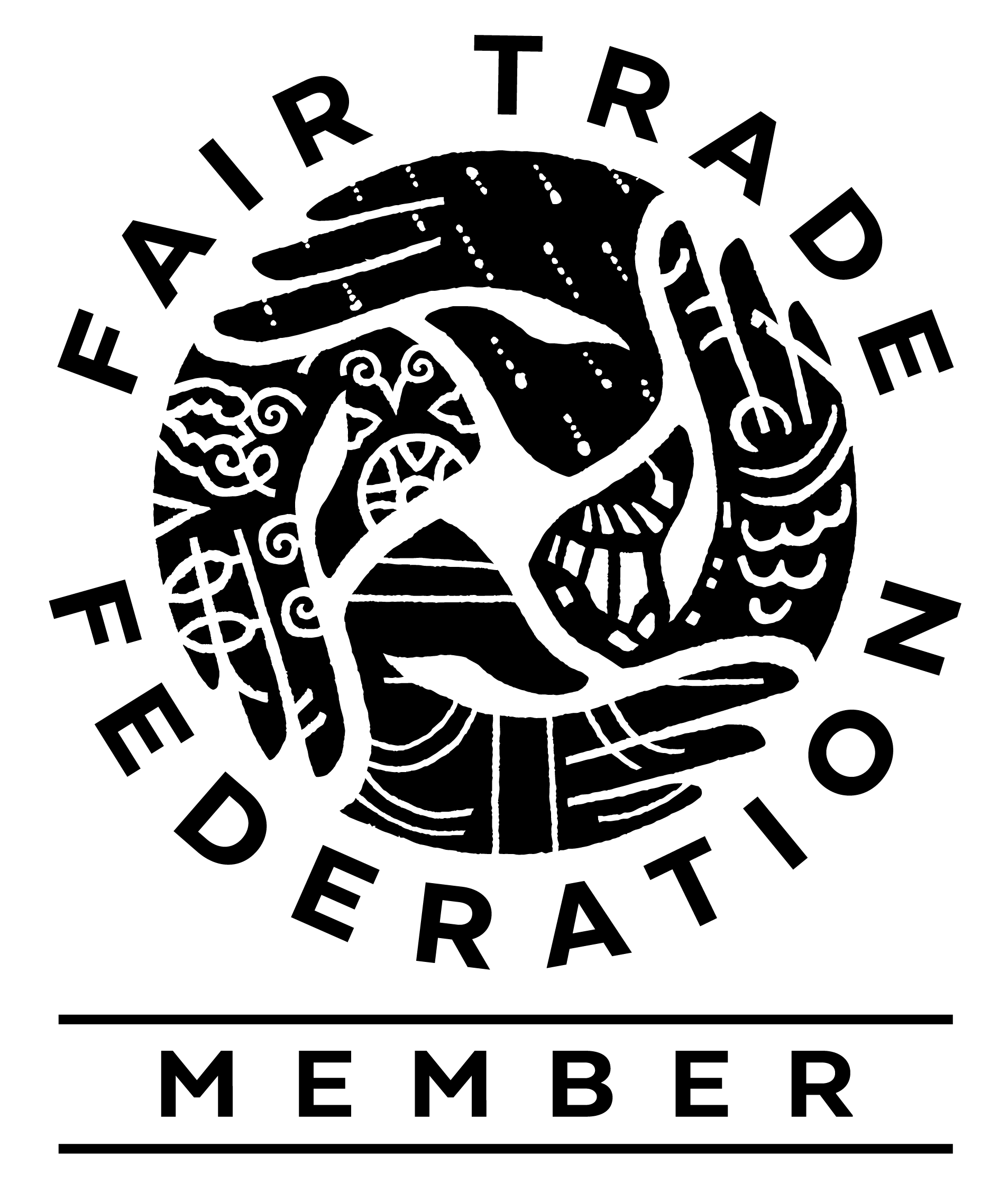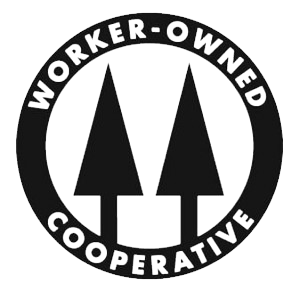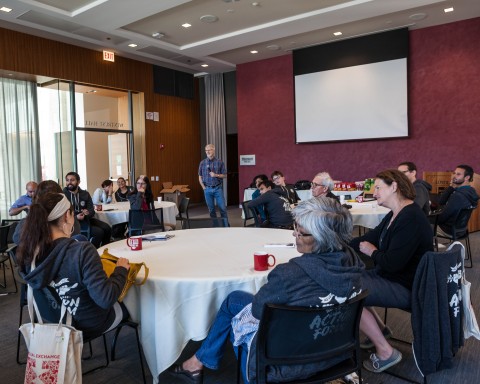
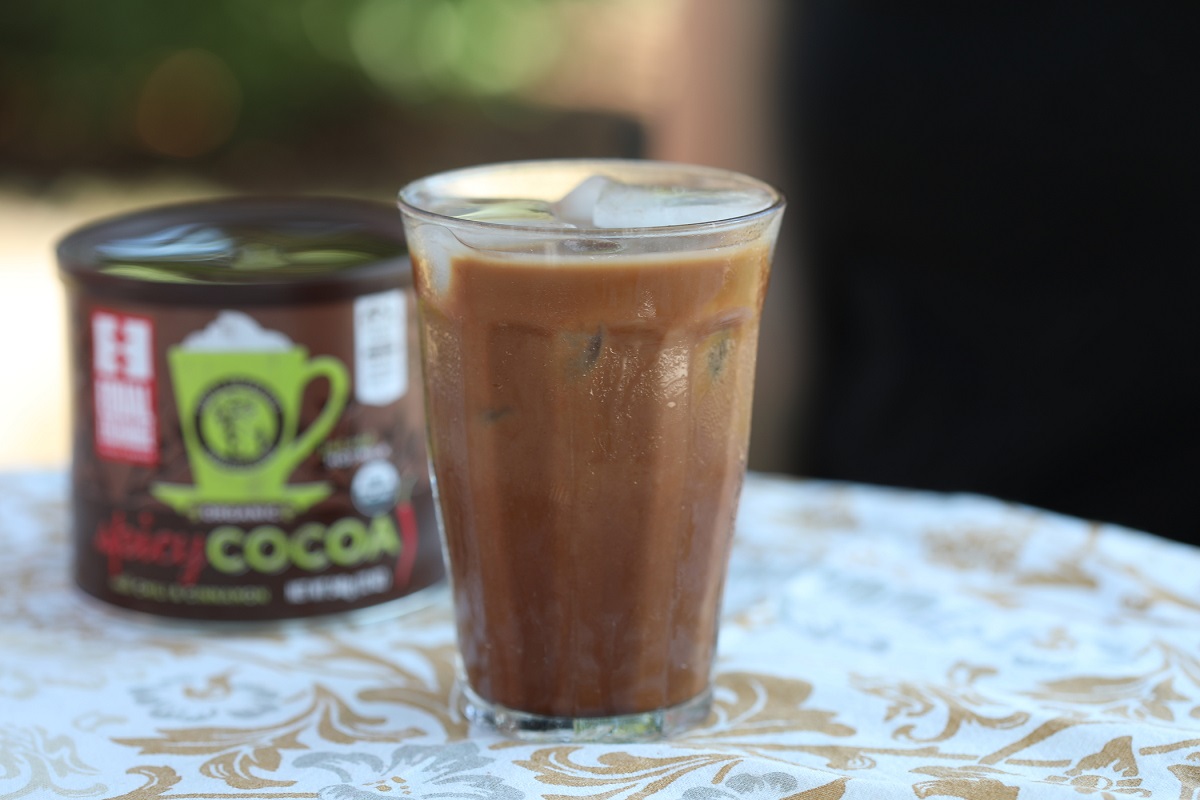


A steep drop down from the Andes mountains, entering into the Amazon Rainforest basin, two cooperatives just 20 miles apart, simultaneously formed parallel visions. Both the Producer Association of Santa Rosa de Chiriari (APROSAROCH) and the Producer Association of Sonomoro Naylamp (APANS) were founded in 2002 as fruit co-ops, producing bananas and oranges, respectively, for the Peruvian internal market. Around ten years ago, the volatile market took a swing for the worse. The co-ops were unsure if they would be able to continue working in fresh fruits and were forced to look for alternative crops. Both found hope in cacao and have been dedicated to its commercialization ever since.
APROSAROCH and APANS beans are used in chocolate chips blended with beans from two San Martin co-operatives: Acopagro and Oro Verde. In June, two members from Equal Exchange and one from our Canadian sister co-op, La Siembra visited with these co-ops and many of their farmer members. A common theme from our conversations was the challenges around climate change- more specifically the difficulty in predicting the harvest cycle. The wet season is becoming wetter and the dry season is becoming drier. Floods and droughts are becoming more and more common.

For example, last winter 2017, Peru experienced well above average rainfall in the rainy season. This excess precipitation affected the co-ops with waterlogged soils that delayed flowering and cocoa pod production on the trees and washed out roads that delayed the transport of cacao beans to external markets. This year again, the cocoa harvest is a bit behind schedule, but farmers are learning to adapt with different tree pruning and compost techniques on the farm.

At the same time, warmer weather has changed the climates of nearby mountain foothills, such as in the nearby Llaylla district. Cool, high altitude micro-climates once suited for coffee, are now warming enough to be suitable for cacao. The prevalence of the devastating effects from coffee leaf rust have further encouraged farmers to make the switch to cacao. APROSAROCH and APANS cooperative leaders noted that they have increased in cocoa farmer members from these once coffee-growing regions.
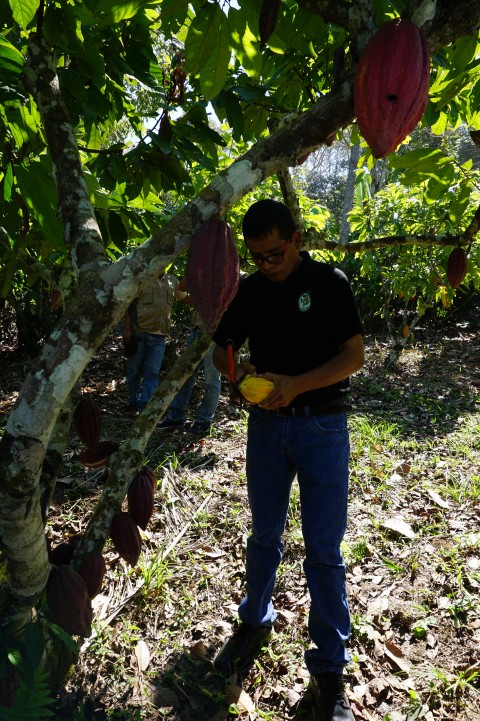
Our visit highlighted that the hard work and dedication to cacao is at the core of these co-operatives. It is inspiring to know that APROSAROCH and APANS are working closely with their farmers and technical teams to come up with solutions to mitigate the effects of climate change.
Maybe you’re searching for ideas for what to do with leftover melted chocolate from another project or dessert. Or maybe your delicious bars suffered accidental hot-weather neglect and you need a way to use up the squishy, melted results. Never fear — chocolate is wonderfully versatile. We like using chocolate molds to turn liquefied chocolate into treats with a custom look.
Let these instructions be your guide as you melt (or re-melt), temper and form it into all kinds of creative shapes, right in your own kitchen. Break out of the square and try it today!
-A mold. You can buy specially-made candy molds in fun shapes online and in many retail stores. You can also try old-fashioned muffin tins or silicone ice cube trays. Another option is to position your favorite cookie cutters on a baking sheet covered with waxed paper!
-High quality chocolate. We use Equal Exchange’s Fair Trade and organic Dark Chocolate. Chose one of our specialty bars, like Dark Chocolate Mint Crunch or Dark Chocolate Orange for extra flavor.
-A microwave.
-A microwave-safe bowl.
-A spatula.
-A candy thermometer.

Real chocolate melts at just below 100° F. After it’s melted, it must be re-tempered, so that it will set correctly and retain its sheen and snap. You can do this at home! Chop up a bar and heat it in a bowl for 30 seconds at a time in your microwave at half-power, stopping to stir every time the microwave beeps. When all the chocolate is completely melted, heat it in short bursts to bring it to 115° F. Keep track with the candy thermometer. Then, stirring the chocolate continuously, allow it to cool to 90° F.
Pour or spoon the melted the chocolate into your mold. A gentle shaking motion can help the chocolate work into corners and crevices. If you’re making lollipops, this is when you insert the stick! Twist to coat the stick to help it adhere to the chocolate, and then lay it flat in the stick-channel of the mold.
For this step, patience is required! Set your mold or baking sheet in the freezer, making sure it’s level. Your candy will be ready to pop out in 5-10 minutes, depending on the size of the mold. Wipe off any excess moisture with a paper towel and enjoy!
As with all fine chocolate, make sure to store leftovers in an airtight container in a cool, dry place.
… not that there will be any leftovers.
If you’ve mastered chocolate molds, you may like our post on Chocolate Covered Strawberries.
Or sign up for our biweekly newsletter to get all the latest fair trade recipes.

From Jerusalem: A Cookbook, by Yotam Ottolenghi and Sami Tamimi
A coffee cocktail? Why not! This Cold Brew Lime Daiquiri is for the adults in the room. The berry and chocolate notes of the African coffees we recommend for the recipe pair beautifully with tart lime juice.

This cold brew cocktail can elevate your dinner party -- or help you unwind in the backyard on a hot summer day.
That was simple! Now, enjoy your Cold Brew Lime Daiquiri. Cheers!

In a blender, process the tomatoes and water until completely smooth. In a pot add the olive oil, onion strips and salt. Saute for 2–3 minutes. Add the chicken cutlets and sear on one side till golden brown, flip and repeat on the other side. Add the processed tomatoes and cook over medium heat till the chicken is done. Drain the chickpeas and wash them. Add them to the chicken pot, cook over medium heat for 7–10 minutes.
In another pot, add the maftoul pearls, olive oil, chickpeas, allspice, cumin, and salt. Add 4 cups of the chicken tomato broth. Cook on low heat, covered for 5–7 minutes. Turn off the heat, Allow it to stand for 10 minutes, then fluff with a fork.
To serve, place the maftoul pearls in your serving dish. Top with shredded chicken or whole chicken cutlets. Add some chickpeas and a ladleful of broth. Serve with more tomato broth on the side.
Recipe courtesy of PARC
By Frankie Pondolph, Action Forum Organizer
Building off of the success of our June Summit, the Action Forum hosted our second summit of the year on July 7th and 8th-bringing together EE worker-owners, action forum members, farmer partners and alternative trader friends for two days of learning, engaging and connecting. On the first day, forty of us gathered in a room overlooking Chicago’s downtown, the room filled with threads of conversation about what brought each of us to the gathering and how far we had traveled.
Picture above attendees at Midwest Summit Photo Credit: Danielle Robidoux
Our day opened with a keynote from Silvia Roblero Torres from CESMACH cooperative in Chiapas, Mexico. Silvia told the courageous story of CESMACH and how they organized against a behemoth buyer (Starbucks), who began imposing business practices and ultimately tried to leverage control over the cooperative. The farmers organized a strategy of sending faxes to other coffee buyers announcing their break from Starbucks. CESMACH sought new buyers that would respect and support their community-based organization of small farmers. Todd Casperson and Phyllis Robinson of Equal Exchange received their fax and wasted no time-traveling down to Chiapas. Equal Exchange went on to purchase ten containers of coffee (60% of CESMACH’s harvest that year).Thus beginning Equal Exchange and CESMACH’s long standing relationship. I encourage you to read the full story of CESMACH’s break from starbucks by visiting this link, to read a blog post written by Phyllis Robinson.
Pictured above Silvia Roblero Torres of CESMACH and Phyllis Robinson of EE Photo credit: Danielle Robidoux
Silvia’s keynote set the stage for our time together, echoing themes of strong relationship building, the power of organizing and the importance of building people and planet-centered models of trade. After the keynote, we highlighted various workshops ranging from themes of the consolidation of our food system, lessons from building alternative trade organizations, the story of CESMACH and operating independant grocery stores in todays market climate. We heard stories from Pushpika Freitas founder of Marketplace: Handwork of India, Professor Phil Howard from the Department of Community Sustainability at Michigan State University, Silvia Roblero Torres certification and sales manager at CESMACH, and Jeff Heinen owner of Heinen’s independent foodstores. The goal was to highlight and bring together people telling their story of alternatives, speaking honestly about their mistakes in building these alternatives, and analyzing the consolidation of US supply chains to try to understand how we can work together in new ways for the future ahead.
On day two, we carved out time to learn more deeply about what brought each other to this summit and what each participant hoped to gain. The room was filled with stories of people organizing a food co-op in Chicago’s Rogers Park neighborhood, student activists, community organizers focusing on nutrition and health, people launching buying clubs out of their homes, and travelers from Equal Exchange delegation trips to name a few. Attendees than organized into three working groups comprising of themes around education/communication, consolidation of the food system and markets/sales. This was our work for the year ahead- to begin to organize ourselves into working groups around three emerging topics, co-sharing our work to build the action forum alongside our membership base.
Pictured above attendees of EE Midwest summit Photo Credit:Danielle Robidoux
Through our summits we envision creating a physical space for people to learn about and engage around issues affecting our food system- we hope to create ways for people to stay connected and to use the Action Forum space as a bridge to connect long after the summit. We have a lot to learn from each other, our communities, histories and past- and it is my hope that after we embark to our homes, we continue to carry our Action Forum community with us- to continue on a path of building a just, democratice food system, together.
To learn more about our action forum community and future summits/events, visit: http://equalexchange.coop/action-forum or get in touch with us directly at eeactionforum@equalexchange.coop.
For over ten years, the Catholic parish of St. Mary of the Angels in the Roxbury neighborhood of Boston, Massachusetts, has been a constant and significant supporter of Equal Exchange and the farmers we represent. St. Mary’s serves Equal Exchange coffee at fellowship after Mass and re-sells thousands of dollars’ worth of coffee, chocolate and other products at quarterly table sales.
A significant number of parishioners at St. Mary’s are originally from the Dominican Republic, where Equal Exchange has a close and longstanding relationship with CONACADO, the National Confederation of Dominican Cacao Producers. CONACADO has supplied us with cacao for our chocolate bars for 13 years. A coincidence a few years ago illustrated the importance of the Dominican connection. When an Equal Exchange staffer was at St. Mary’s presenting some Power Point slides of farmer-members of CONACADO, one of the parishioners in the audience pointed to a slide and cried out “That’s my cousin!”

On a recent Sunday after Mass, Abel Fernandez, one of the founders of CONACADO, spoke at St. Mary’s, to a mostly Dominican audience. He related the history of his cooperative, from its beginning in 1985 with 700 members and and growth to its current size of over 10,000; and its effect on the Dominican cacao industry. Before CONACADO, he said, Dominican cacao was of low quality, and mostly sold for a below-market price to candy companies in the United States. The industry was controlled by a few processors who set the “take-it-or-leave-it” price.
CONACADO changed the industry in the Dominican Republic in many ways. They:
The cooperative offers farmers an alternative to the oligopoly of fat-cat processors. Currently, about a quarter of the Dominican Republic’s small cacao farmers are members of CONACADO.

Abel’s presentation was accompanied by chocolate croissants and a chocolate fountain, both made with Equal Exchange chocolate. The fountain also used Equal Exchange organic and fairly traded bananas for dipping—it was a big hit with the children.
Post a picture of yourself in the Great Outdoors with your favorite Equal Exchange beverage or snack and tag it #eeoutdoors — you could win one of four prize packs worth $50 each!
We think a strong connection to nature is healthy! That’s why we source our coffee, tea, chocolate and other products from people who farm using sustainable practices. What do YOU do to show your appreciation for the world outside four walls?
A picture speaks a thousand words. Whether your backyard is a desert or a rainforest, whether you like to kayak or prefer croquet — we want to see it! This summer, share your epic adventures with EE by entering our Instagram contest!
.
Here’s how to win. First, follow @equalexchange. Then post to Instagram by 8/31/18, using #eeoutdoors! Entries must depict you doing an outdoor activity that you love, with an EE product in the shot.
We’ll award prizes to the two posts with the most likes. And our editors will pick our favorites and award prizes to them, too. That’s FOUR chances to win! Check out #eeoutdoors on Instagram to see the posts!
.
The fineprint:
Equal Exchange is the administrator of this promotion. It is not sponsored, endorsed or administered by, or associated with Instagram.
We must receive your entry by 11:59 PM EST on 8/31/18. By entering, you affirm that you are 18 or over and a US resident. EE employees are not eligible to win.
Photos must have been shot outdoors and must contain an EE product to be considered. Entries must tag @equalexchange and use the contest hashtag. EE reserves the right to disqualify any entry deemed offensive, inappropriate or otherwise unsuitable.
Two winning entries that adhere to the rules will be chosen based on likes. An impartial jury of EE staff members will choose two additional entries that adhere to the rules. We’ll contact winners by direct message on Instagram. Winners will have one week to claim their prizes by providing a US mailing address (not a PO box). We’ll ship prizes via UPS Ground.
We’ll announce the winners by 9/10/18.
At Equal Exchange, we work hard to bring you organic, sustainable and fairly traded coffee, tea and chocolate. What do we do when we’re not doing that? Let us show you!
EE worker-owners from every region of the US sent in pictures of ourselves, our friends and our family members (and our dogs!) spending time in the Great Outdoors. For some of us, that means a long hike or an ambitious workout. Others would rather dig in our gardens, relax by the shores of an inviting lake, or hunt for bugs in the backyard.
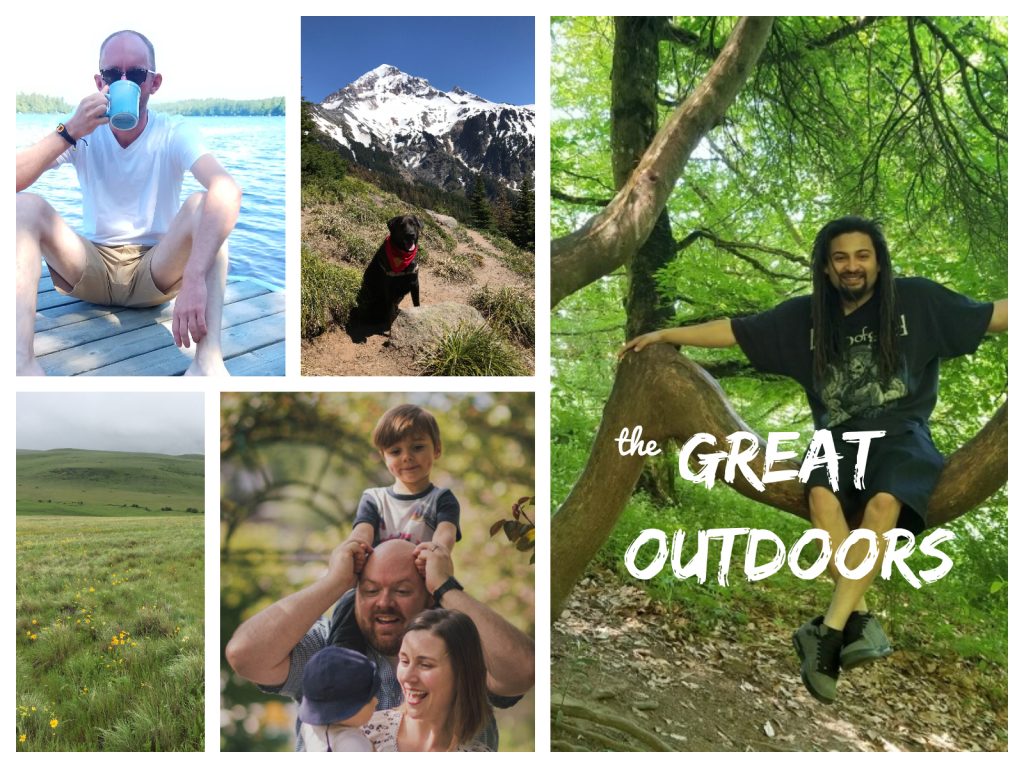
Share a pic that captures YOUR epic nature adventures and love of fair trade on Instagram. We’re giving out prizes! Read the contest post for details.
As our co-op has grown, we’ve become a far-flung group of people who work out of offices all over the country. You’ll notice different kinds of scenery in the background of these snapshots. But one thing we have in common is that we care about the impact our business has on the natural world. We want to make sure Equal Exchange is environmentally responsible. We strive to build supply chains that are fair to people and respectful of the earth.
EE supports growing methods that are better for the environment. Small-scale, diverse farming may not be as efficient as huge, monocrop plantations. But small farms and cooperatives are more sustainable in the long run — economically, socially, and for the natural world that surrounds us.

Thanks for doing your part by shopping for organic and fairly traded foods. And thanks for taking the time to explain to your friends, family and coworkers why it matters. Sound ecological practices are everyone’s responsibility.
Not sure what to say? We’ve got you covered with Fair Trade talking points.
When we feel a connection to nature, we’re more likely to make an effort to protect it. That’s why Equal Exchange worker-owners are all about getting out — wherever we may be — to have an adventure. We hope to see you there!
Photo credits:
Collage 1 clockwise, from top left: Ashley Krant at Badlands National Park in South Dakota; Liza in Vermont (photo by Megan Chisholm); a friendly snail (photo by Jill Taylor); Marlon Cifuentes in Providence, Rhode Island; Laura Bechard with Apuka the dog in New Hampshire (photo by Erika Szonntag)
Collage 2 clockwise, from top left: Jeff Purser at Songo Pond in Maine; Cutch the dog at Mount Hood in Oregon (photo by Stephanee DiMaggio); Marcus Jones in Oregon (photo by Stephanie O’Rourke); Andrew, Alison, Vinnie and Louie Booth-Gribas at Ballard Locks in Washington (photo by Vera Pash); Zumwalt Prairie in Oregon (photo by Katie Sharpe).
Collage 3 clockwise, from top left: Evan at Diana’s Baths in New Hampshire (photo by Jill Taylor); an EE cup in Michigan (photo by Ravdeep Jaidka); Dave Tybor, Rachel Tybor and Lucas Fowler at Kelly Park in Florida; Shawn Seebach at Dog Mountain in Washington; Ned the dog with Emily Nink, Hannah Bassett and Meghan Bodo in New Hampshire (photo by Ian MacLellan).


